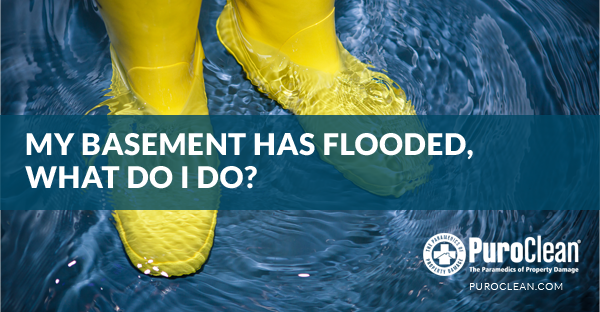Flooded Basement Cleanup and Restoration
After your basement floods, make sure that it’s safe to enter your home by checking for structural damage, such as cracks, holes or warping. Immediately shut off the electrical and water supply to your home. If you must walk through floodwater, protect yourself from contaminants by wearing watertight gear. Then, take pictures of the damages and call your insurance company. Next, the drying process must begin immediately, after which you can sort out the affected goods and clean up the basement.
The first things to do:
- If you’re not sure if you can tackle the flooded basement cleanup and restoration yourself, call the water damage experts at PuroClean immediately.
- Be aware of electrical wires that are under the water level and turn off your home’s power at the main breaker switches.
- If the flooding is due to a burst water pipe in your home, shut off the main water supply valve.
- Avoid direct contact with floodwater, which may contain dangerous contaminants. If you must walk through floodwater, wear protective clothing, such as disposable overalls, eyewear, gloves and a face mask.
- Call your insurance company, take of photos and document all items that have been damaged or need to be replaced.
- Completely dry the basement as quickly as possible to avoid further damages to contents and structure, as well as the formation of mold. Suck up the water with a sump pump, a Wet-Dry vacuum, and use dehumidifiers. This may take up to 2 weeks.
- Ventilate the basement as much as possible, use fans and open windows if the weather allows, but not when the outside humidity is high.
- Remove the baseboards (if present) and drill 1-inch holes halfway between the wall studs at the base of the walls to allow moist air from behind the walls to evaporate.
Cleaning up the basement:
- Rescue affected items by quickly removing them from floodwater to avoid mold growth, warping and rot. Items that suck up a lot of water (such as carpet and furniture) can usually be salvaged if they have been in water for less than 24 hours.
- Make a list of what belongings can be restored and what needs to be thrown away. This will help you with your insurance claim.
- After everything has been dried, clean and disinfect the basement contents and structure (walls, foundation floor, drywall, etc.). You may need to discard the drywall and wood if a lot of mold has developed.
- Don’t use bleach to clean mold, because bleach kills live mold, but not mold spores. Household detergent is preferable.
- For areas larger than 10 square feet that are affected by mold, contact the mold remediation experts at PuroClean. We can identify the moisture source and restore the affected surfaces.
- Make any necessary repairs, such as filling foundation cracks, replacing damaged drywall (choose a mold resistant type) and sealing windows and vents.
To prevent a flooded basement, consider investing in a sump pump and a generator, upgrading your foundation drains and sloping the ground away from the house. If you’re looking for professional help to restore a flooded basement, the PuroClean team is ready to step in and help take care of all these steps for you.


